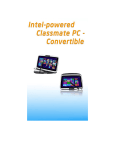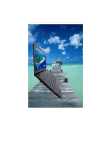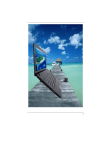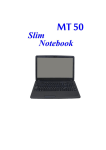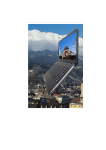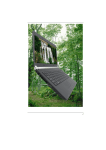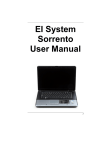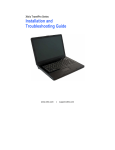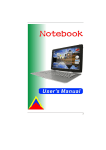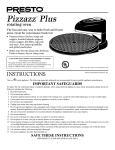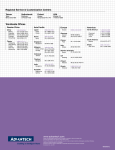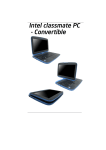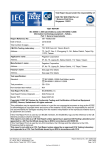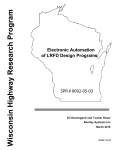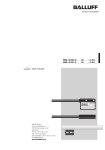Download Using the Notebook Computer
Transcript
i Preface Copyright 2011 All Rights Reserved. The information in this document is subject to change without prior notice in order to improve reliability, design and function and does not represent a commitment on the part of the manufacturer. In no event will the manufacturer be liable for direct, indirect, special, incidental, or consequential damages arising out of the use or inability to use the product or documentation, even if advised of the possibility of such damages. This document contains proprietary information protected by copyright. All rights are reserved. No part of this manual may be reproduced by any mechanical, electronic, or other means in any form without prior written permission of the manufacturer. Limitation of Liability While reasonable efforts have been made to ensure the accuracy of this manual, the manufacturer and distributor assume no liability resulting from errors or omissions in this manual, or from the use of the information contained herein. Notice: Changes or modifications not expressly approved by the party responsible for compliance could void the user’s authority to operate the equipment. Shielded interface cables and a nonshielded AC power cord must be used in order to comply with emission limits. This equipment is to be used with power supply: 90W There is no internal power supply. i Table of Content BEFORE YOU START ............................................................................... 2 LET YOUR COMPUTER ACCLIMATE ITSELF .............................................. 6 HEAT, COLD, HUMIDITY, AND GLARE .................................................... 7 SUITABLE PLACE TO WORK ................................................................... 7 INTRODUCTION........................................................................................ 9 LEFT VIEWS ...................................................................................... 12 RIGHT VIEW ...................................................................................... 13 GETTING STARTED ............................................................................... 16 CONNECTING THE AC ADAPTER ......................................................... 16 TO INSTALL THE BATTERY PACK:........................................................ 18 TO REMOVE THE BATTERY PACK: ...................................................... 19 USING THE NOTEBOOK COMPUTER ....................................................... 21 LCD CARE ........................................................................................ 21 EXTERNAL CRT DISPLAY ................................................................... 21 TOUCHPAD PRECAUTIONS ................................................................. 22 DATA STORAGE AND RETRIEVAL ........................................................ 23 THE BATTERY POWER SYSTEM .......................................................... 23 PREPARING THE BATTERY PACK FOR USE (BATTERY CALIBRATION) .... 24 AUTOMATIC BATTERY PACK CHARGING FUNCTION .............................. 25 BATTERY STATUS .............................................................................. 25 BATTERY LOW WARNING ................................................................... 25 HELP WINDOWS ................................................................................ 27 DESKTOP .......................................................................................... 27 INTERNET CONNECTION ........................................................................ 32 RUNNING BIOS SETUP ......................................................................... 34 MAIN SETUP ..................................................................................... 36 INFO SETUP ...................................................................................... 37 ADVANCED ........................................................................................ 38 SECURITY SETUP .............................................................................. 38 BOOT SETUP ..................................................................................... 39 EXIT SETUP ...................................................................................... 39 ii SUPER POSH ...................................................................................... 41 ADVANCED PAGE .............................................................................. 44 OPTIMIZING WINDOWS SETTING: ........................................................ 51 HARD DISK MENU.............................................................................. 53 CPU ................................................................................................. 54 RAM: ............................................................................................... 54 WARNING:......................................................................................... 55 SPECIFICATION ..................................................................................... 60 iii 1 Before you Start Conventions of This Manual Use this manual will help you get the most from your notebook computer. If you are an experienced user of computers and/or Microsoft’s Windows operating systems, you might find it useful to read the Quick Start Guide that comes along with your accessories. If you are a less experienced user, you should get through the manual carefully before using your system. Whether or not you are an experienced user, you should consult on the Troubleshooting Chapter if you encounter any problems with your notebook. EMC Classification You are cautioned that changes or modifications not expressly approved by the part responsible for compliance could void the user’s authority to operate the equipment. This equipment has been tested and found to comply with the limits for a Class B digital device, pursuant to part 15 of the FCC rules. These limits are designed to provide reasonable protection against harmful interference in a residential installation. This equipment generates, uses and can radiate radio frequency energy and, if not installed and used in accordance with the instructions, may cause harmful interference to radio communications. However, there is no guarantee that interference will not occur in a particular installation. If this equipment does cause harmful interference to radio or television reception, which can be determined by turning the equipment off and on, the user is encouraged to try to correct the interference by one or more of the following measures: Re-orient or relocate the receiving antenna. Increase the separation between the equipment and receiver. 2 Connect the equipment into an outlet on a circuit different from that to which the receiver is connected. Consult the dealer or an experienced radio/TV technician for help. Safety Precautions This section is designed to assist you in identifying potentially unsafe conditions while working with this product. Required safety features have been installed in the computer to protect you from injury. However, you should use good judgment to identify potential safety hazards: 1. Please read these safety instructions carefully. 2. Please keep this User's Manual for later reference. 3. Please disconnect this equipment from AC outlet before cleaning. Don't use liquid or sprayed detergent for cleaning. Use moisture sheet or cloth for cleaning. 4. For pluggable equipment, that the socket-outlet shall be installed near the equipment and shall be easily accessible. 5. Please keep this equipment from humidity. 6. Lay this equipment on a reliable surface when installed. A drop or fall could cause injury. 7. Make sure to use the right voltage for the power source when connecting the equipment to the power outlet. 8. Place the power cord in such a way that people can not step on it. Do not place anything on top of the power cord. 9. All cautions and warnings on the equipment should be noted. 10. If the equipment is not used for a long time, disconnect the equipment from the main power outlet to avoid being damaged by transient overvoltage. 11. Never pour any liquid into the opening, this could cause fire or electrical shock. 12. Never open the equipment. For safety reason, the equipment should only be opened by a qualified service personnel. 13. If on the following situations arises, get the equipment checked by a service personnel: a. The Power cord or plug is damaged. b. Liquid has penetrated into the equipment. c. The equipment has been exposed to moisture. d. The equipment has not worked well or you cannot get it work according to the user's manual. e. The equipment has dropped and damaged. f. If the equipment has obvious sign of breakage. 3 14. Do not leave this equipment in an environment unconditioned, storage temperature above 60C (140f), it may damage the equipment. 15. The unit can be operated at an ambient temperature of max. 5C to 35C. 16. The sound pressure level at the operators position according to IEC 704-1: 1982 is equal or less than 70 dB(A). 17. Power Cord Requirements The power cord set used with the AC adaptor must meet the requirements of the country where you use the AC adaptor, whether it is 100-240 Vac. The following information explains the requirements for power cord set selection. The cord set must be approved for the country in which it is used. The appliance coupler must have a configuration for mating with a CEE7/EN60320/IEC 320/NEMA/ JIS C 8303 appliance inlet. A. For U.S. and Canada: The cord set must be UL Listed and CSA Certified. The minimum specifications for the flexible cord are No. 18 AWG, (2) Type SPT-2, and (3) 2-conductor. B. For Japan: All components of the cord set must bear a “PSE” mark and in accordance with the Japanese Dentori Law. The minimum specifications for the flexible cord are .75m ㎡ conductors, (2) Type VCTR or VCTFK, and (3) 2-conductor. The cord set must have minimum rated current capacity of 7 A. The attachment plug must be a two-pole, grounded type with a Japanese Industrial Standard C8303 (15 A, 125 VAC) configuration. C. For Other Countries: The cord set fittings must bear the certification mark of the agency responsible for evaluation in a specific country. The flexible cord must be of a HAR (harmonized) type H03VVH2-F. 4 The cord set must have a current capacity of a least 2.5 Amperes and voltage rating of 125 or 250 Vac. MODEL H42IAx/H43IAx (x=0~9) is designed to use with the following AC adapter model only. 18. 19. 20. 21. Delta Electronic, Inc. ADP-90SB-AB (90W, 2 pin) Huntkey Electronic Co., LTD HKA0901904/8D(90W, 2 pin) When using your telephone equipment, basic safety precautions should always be followed to reduce the risk of fire, electric shock and injury to persons. These precautions include the following: Do not use this product near water, for example, near a bathtub, washbowl, kitchen sink or laundry tub, in a wet basement or near a swimming pool. Avoid using a telephone (other than a cordless type) during an electrical storm. There may be a remote risk of electric shock from lightning. Do not use the telephone to report a gas leak in the vicinity of the leak. Use only the power cord and batteries indicated in this manual. Do not dispose of batteries in a fire. They may explode. Check with local codes for possible special instructions. Do not use the AC adapter near open water or other liquids. Never spill liquid into the AC adapter. Danger of explosion if battery is incorrectly replaced. Replace only with the same or equivalent type recommended by the manufacturer. Dispose of used batteries according to the manufacturer's instructions. Never remove the battery pack while the power is on as this may result in data loss when the system loses power. The input receptacle is used as the main disconnecting device. This part is hot. Be careful. When you see this symbol, be careful as this spot may be very hot. 22. Laser Warning: Laser Class I Product Caution - Invisible laser radiation when open avoid exposure to beam. The optical drive used with this computer is certified as a 5 Class1 laser device according to the U.S. Department of Health and Human Services (DHHS) Radiation Performance Standard and International Standards IEC 60825-1 (EN60825-1). The device is not considered harmful, but the following precautions are recommended: Do not open the unit. Avoid direct exposure to the laser beam. If the unit requires service, contact an authorized service center. Ensure proper use by reading and following the instructions carefully. Do not attempt to make any adjustment of the unit. Class 1 Laser Product Do not attempt to disassemble the cabinet containing the laser. The laser beam used in this product is harmful to the eyes. The use of optical instruments, such as magnifying lenses, with this product increase the potential hazard to your eyes. For your safety, have this equipment serviced only by an authorized service provider. Things you must remember before working on your computer Let your computer acclimate itself Your notebook can easily stand temperature extremes but it doesn’t like rapid changes in temperature, like going from the cold outdoors to a warm office. Rapid changes in temperature can cause water droplets to condense inside your case, threatening to damage the electronic parts inside. After receiving your notebook when it’s hot or cold outside, try not to power up the computer immediately, let the computer adjust to the room temperature gradually at least for three to four hours. If your system arrives in cold weather, do not apply power to the computer or monitor until they have been allowed to come to room temperature. 6 Heat, Cold, Humidity, and Glare Find a suitable place for your computer that’s not too hot, too cold, too dark, or too bright. Glare can make it hard to read the screen. Try to avoid the computer components from being destroyed if it is overheated, so try to allow plenty of room for air to circulate around the case. Do not block the ventilation opening. Do not place your computer in direct sunlight. Suitable place to work Your computer will run well wherever you’re comfortable but extremes of temperature and humidity can be challenging to your system’s parts. There are some things you can tolerate that the computer can’t – things like static electricity, dust, water, steam and oil. In case you decide to pull over for roadside computing, try to choose a clean, comfortable work area for your system. A lithium-ion battery pack will be available when you are traveling. If you are running your system for the first time on battery power, remove the battery from the package, install it into the system and recharge the battery to fully prepare for service. 7 8 Introduction Please use the adapter recommended in this manual. Preparing your Computer Install the battery pack Connecting the AC adapter Opening the display panel Turning on your computer 9 Knowing your Computer With the LCD screen open, you will see several features important for operating your notebook computer. To avoid damage to the display panel: 1. Try not to slam the display upon closing it. 2. Try not to place any object on top when it is closed or open. 3. Be sure the system is turned off or in suspend mode before you close the display panel. Front View Picture is only for reference Camera 10 LCD Display This LCD panel can only support up to a maximum opening of 115-135 degrees, please do not push it forcibly. Keyboard The keyboard differs for each territory Touchpad Microphone Touchpad Buttons LED Status Indicator System & Power Status Indicators Power ON: Blue RF On: Blue HDD R/W: Blinking Blue Battery LED status Charging: Blinking Blue Full: Blue Battery Low (<6%): Blinking Red Power/Suspend Button Press for 1~1.5 seconds to turn on the system. Press and hold for at least 4 seconds to turn off the system. Press the power / suspend button again to return from the suspend mode. 11 Left Views Kensington Lock CRT Port Ethernet / LAN Port When using a LAN, please use an EMI Shielding Cable to minimize interference when transmitting. USB 2.0 Ports or 3.0 Ports (Optional) 12 HDMI Port Microphone/Audio Line-in Jack Stereo Headphone Jack Right View USB 2.0 Port 13 Enhanced USB 2.0 Port Optical Drive DC In Bottom View Battery Lock Battery Compartment Battery Release Latch 14 15 Getting Started Connecting to a Power Source Connecting the AC Adapter A universal AC adapter is provided to supply your computer with power and also charge the computer’s battery pack. The adapter’s AC input voltage can range anywhere from 100 to 240 volts, covering the standard voltages available in almost every country. To connect the computer to an external power source: Do not use inferior extension cords as this may result in damage to your notebook. The notebook comes with its own AC adapter. Do not use a different adapter to power the computer and other electrical devices. Whenever possible, keep the AC adapter plugged into the notebook and an electrical outlet to recharge the battery. 16 Never turn off or reset your notebook while the hard disk is in use status icon is lit; doing so can result in loss or destruction of your data. Always wait at least 5 seconds after turning off your notebook before turning it back on; turning the power on and off in rapid succession can damage the notebook’s electrical circuitry. Turning On Your Notebook Computer Hold the button down for a second or two and release. The PowerOn Self Test (POST) runs automatically. After the POST is completed, the computer reads the operating system from the hard disk drive into computer memory (this is commonly referred to as “booting” a computer). If your OS (Operating System such as Windows Vista…. etc) is installed, it should start automatically. To turn the notebook off, save your work and close all open applications, click on Start, then Shut Down and select Shut down the computer and click "Yes" or press the power button for 4-6 seconds. Operating on Battery Power Your computer comes with a rechargeable battery pack that lets you operate the computer without an external power source. When the battery pack is fully charged, you can operate the computer under the following conditions: The battery pack initially has a full charge. No peripheral devices are installed. The disk/DVD-ROM drives run no more than 10% of the time Only use batteries that are approved by an authorized dealer. All batteries are not the same and therefore should not be treated as such. Using the wrong battery could cause serious damage to your computer and yourself through toxic emissions. 17 Danger of explosion if battery is incorrectly replaced. Replace only with same or equivalent type recommended by the manufacturer. Discard used batteries according to the manufacturer’s instructions or local laws. Installing and Removing the Battery Pack To Install the Battery Pack: 18 To Remove the Battery Pack: Charging the Battery Pack The installed battery pack charges automatically any time the computer is connected to the AC adapter and an external power source. It is a good idea to occasionally discharge the battery pack fully to preserve its operating performance. 19 20 Using the Notebook Computer Adjusting the LCD Screen Display The LCD screen display can be adjusted by the following key combinations. F4 - Changes Display Mode: LCD-only, CRT/HDMI-only and simultaneous LCD&CRT/HDMI. F7 - Decrease the brightness level. F8 - Increase the brightness level. LCD Care LCD screens are delicate devices that need careful handling. Please pay attention to the following precautions: When you are not using the computer, keep the LCD screen closed to protect it from dust. If you need to clean your LCD screen, use a soft tissue to gently wipe the LCD surface. Do not put your fingers or sharp objects directly on the surface and never spray cleaner directly onto the display. Do not press on, or store any objects on the cover when it is closed. Doing so may cause the LCD to break. External CRT Display You can hook up an external monitor through the 15-pin CRT connector. LCD only CRT/HDMI only Simultaneous LCD&CRT/HDMI You can switch between these display configurations by pressing the key combination [Fn] + [F4]. 21 The Notebook’s Hot Key Controls Fn + F1 : Suspend Fn + F2 : Fan/Silent Mode Fn + F3 : Mute Fn + F4 : LCD/CRT/HDMI Fn + F5 : Volume down Fn + F6 : Volume up Fn + F7 : Brightness down Fn + F8 : Brightness up Fn + F9 : Touch Pad disable/enable Fn + F10 : Wireless LAN On/Off Fn + F11 : Webcam On/Off Fn + Esc : Bluetooth On/Off The TouchPad The touchpad is a rectangular electronic panel located just below your keyboard. You can use the static-sensitive panel of the touchpad and slit it to move the cursor. You can use the buttons below the touchpad as left and right mouse buttons. TouchPad Precautions The TouchPad is a pressure sensitive device. Please take note of the following precautions. 22 Make sure the TouchPad does not come into contact with dirt, liquids or grease. Do not touch the TouchPad if your fingers are dirty. Do not rest heavy objects on the TouchPad or the TouchPad buttons. You can use the TouchPad with Microsoft Windows as well as nonWindows applications. Connecting an External Tracking Devices The system will only enable you to use one tracking device whether it is an internal or external tracking device. Data Storage and Retrieval Data storage and retrieval are two of the most fundamental tasks you will perform when working with your computer. The Notebook is equipped with a hard disk drive (HDD). The HDD is removable allowing for easy upgrades. Power Saving Modes This section contains information on the notebook’s power system, including the AC Adapter, the battery system, recharging the battery, and tips for conserving battery power. The power system is comprised of two parts, the AC Adapter and the battery system. The AC Adapter converts AC power from a wall outlet to the DC power required by the computer. The Battery Power System Before using the computer on battery power for the first time, check the battery status icon on the Windows Toolbar to make sure the battery is fully charged. See Battery Status later in this section for a description and explanation of the Windows Battery icon. Charging the battery takes about 3 hours to charge when the system is in off state. If possible, always charge the battery completely. 23 If you use the battery so frequently that it exceed more than 20 times by fully discharging/charging in a single month alone, we recommend you to perform the “Battery Calibration” process every 3 months to maintain the battery life. Please refer to the topic on “Battery Calibration” describing how to calibrate your system battery discussed on the latter part of this chapter. If you discover the battery life is getting shorter, please perform the “Battery Calibration” process immediately. Removing the Battery Pack To remove the battery pack from its compartment, please refer to Chapter 3, Inserting and Removing the Battery Pack. Preparing the Battery Pack for Use (Battery Calibration) Before using the battery pack for the first time, battery pack should be calibrated in order to get accurate reporting of remaining battery life status.. To calibrate the battery pack follows the instructions below: 1. Insert the battery into the battery compartment and turn on the notebook. If the battery is completely without power go to the next step. Otherwise, let the battery run down until the battery low-low warning beeps are heard. The system will automatically enter Suspend mode. 2. Turn the notebook off. Connect the AC adapter and let the battery fully recharge. When the battery charge indicator turns off, the battery is fully charged. 3. Turn On the notebook, let the battery run down until the battery is in low-low state and you hear a warning beeps. The system will automatically enter the Suspend mode. You can now connect the AC adapter. 4. The battery pack is now calibrated properly. In general, using the battery until the low-low battery-warning indicator appears and fully recharges the battery each time (full discharge/charge cycle) will ensure the accurate reporting of the battery gauge status. 24 Automatic Battery Pack Charging Function To charge the battery, while the battery pack is in the notebook, plug the AC adapter into the notebook and an electrical outlet. The charging time is approximately 3-4 hours when the notebook is turned off and approximately 6-7 hours when the notebook is turned on. When the battery is fully charged, the battery charge indicator becomes off. If system runs at heavy loading or in a high temperature environment, the battery may not be fully charged. You need to continue to charge it with the AC adapter plugged in until the charging LED turns off. Battery Status Windows 7 has an applet in the Control Panel that will display an icon in the Windows taskbar indicating when the notebook is running on battery power or is attached to the AC adapter. This applet also displays a meter that indicates how much charge is remaining in the battery. Battery Low Warning When the pack initially reaches the “Battery Low” state approximately 7 ~ 10 minutes of the usable battery life is left. You will hear an audible beep signal every 15 seconds alerting you to the “Battery Low” status. When the battery power reaches the “Battery Low Low” status the beeping sound will accelerate. Your battery now has 1 ~ 2 minutes of battery charge remaining. You must save your data or connect AC power immediately; otherwise, you may lose your data. Sound Continuous beeping every 5 seconds Beeping accelerates Meaning Battery Low: Indicates that there is 7 to 10 minutes charge remaining. Battery Low Low: Indicates that there is 1 to 2 minutes of battery charge remaining. Save your work and turn off the notebook, or 25 connect the AC adapter. When there is only one minute of battery charge remaining, the notebook will suspend to the HDD and power off. You should connect AC power and resume to save your work. Danger of explosion if battery is incorrectly replaced. Replace only with the same or equivalent type recommended by the manufacturer. Dispose of used batteries according to the manufacturer's instructions. Never remove the battery pack while the power is on as this may result in data loss when the system loses power. Resetting the System After installing a software application package, you may be prompted to reset the system to load the changed operating environment. To reset the system, or “reboot,” press the [Ctrl]+[Alt]+[Delete] keys simultaneously. This is known as “warm boot.” This key combination acts as “software” reset switch when you encounter hardware or software problems, which lock up the notebook. If this key combination does not shut down the notebook, you can reset the notebook by using the notebook’s power button. Should the notebook lock up for some reason, pressing this button powers the notebook off. Adjusting the Brightness To adjust the brightness on the LCD screen, press and hold down the [Fn] key in the lower left hand corner of the keyboard and press the [F7] key to decrease the brightness or [F8] to increase the brightness. 26 Using the Windows Help Windows For Windows 7 help, click Start Help and Support icon will open the dialog box. Desktop Desktop may vary differently on the software installed in your notebook with different or additional shortcuts. 27 Recycle Bin Used for storing deleted files in case you want to recover and save it in your system. The files will only be deleted from the Recycle Bin permanently only if you empty it by right clicking your mouse and select the “Empty Recycle Bin”. Start Button Allows easy access to all Windows programs. 28 The Start menu allows you to adapt and show the programs used most frequently. If you wish to keep an item, right click the item and click Pin to Start menu. Log Off will enable the current user to log off and allows a new user to log on. Turn Off Computer allows you to shut down, restart, and Stand by modes for power saving purposes. Taskbar When you open a program, its icon is displayed at the taskbar for you to conveniently move between programs by clicking the relevant button. To add or remove toolbars from the taskbar: right click an empty spot on the taskbar, select Toolbars choose the toolbar you want to add. Notification The icons that appear here are for quick access to some programs and computer functions that you frequently used. To prevent Windows 7 from hiding icons: From an empty spot on the Taskbar, right click your mouse and select the Properties, remove the checked mark on the Auto-hide the taskbar. 29 Control Panel It is in this area that you can change how Windows looks and works. Click Start Control Panel dialog box. There are two interfaces – Classic View. 30 31 Internet Connection Using Wireless LAN Network for Connection to Internet 32 33 Running BIOS Setup The Setup Utility is a hardware configuration program built into your computer’s BIOS (Basic Input/Output System). It runs and maintains a variety of hardware functions. It is menu-driven software, which allows you to easily configure and change the settings. The BIOS contains manufacture’s default settings for the computer’s standard operations. However, there are occasions when you may be required to modify the default settings in the BIOS. The BIOS allows you to set up passwords to limit access to users. This is an important feature because a great deal of vital information is carried within the computer nowadays. Unauthorized access can be prevented. Later in this chapter, you will learn how to use this security feature. Entering the BIOS Setup Screen First turn on the power. When the BIOS perform the POST (PowerOn Self Test), press F2 key quickly to activate the BIOS Setup Utility. You may need to press F2 key fairly quickly. Once the system begins to load Windows, you may have to retry by cycle-power on again Leaving the BIOS Setup Screen When you have finished modifying the BIOS settings, exit the BIOS. It takes a few seconds to record changes in the CMOS. BIOS Action Keys Function Key Command Description ESC Exit Leaves a sub-menu to return to the previous menu OR exits the BIOS setup while saving changes. Enter Go to Sub Screen Shows the Sub Menu 34 F1 F9 General Help Default F10 Save and Exit <Tab> Select a field Select an item Select an item Select a menu Select a menu - Lower value + Higher value Shows the Help Screen Set to default Saves changes and reboots the computer. Selects the next field. Selects the next upper item. Selects the next lower item. Selects the right item Selects the left item Selects the lower value within a field. Selects the higher value within a field. Modifying the BIOS Settings The BIOS setup main menu is subdivided into sub-menus. Each menu item is described in this section. 35 Main Setup 36 Info Setup 37 Advanced Security Setup 38 Boot Setup Exit Setup 39 40 Super POSH Super POSH is an integrated AP which has great benefit for the system. It includes “Super Power” “Super OSD” “Super Speed” and “Super HDD.” These applications enable you to run the power saving scheme in your system, enable shortcut icon, optimize your system configuration, and detect your system current status. Super POSH System Tray Use your mouse left button by clicking once on the icon will show the status bar. Use your mouse left button by clicking twice on the icon will show the controller at the right side of the screen and main page. 41 The main functions are as follows: Capslock / Silent mode / Touchpad / WLAN / Webcam / Bluetooth / Numlock / Scroll lock / Brightness / (sound) volume / Discrete / UMA Super Power Super Power provides an integrated page for user to control power management. It could increase battery life and provides effectiveness of your system. There are 4 Modes for selection with their description shown below: 42 Mode Power saving Normal Icon High performance Dynamic switch Description Decrease system performance to provide more battery life Balance system performance Provide system best performance Switch to “Power saving” & “ Normal” mode automatically on battery mode, and auto switch to “High performance” mode when plug-in. Power Status Show Current Power Source from AC or Battery. Battery mode Plug-in and Charging Plug-in and Full AC only Setting Page Monitor HDD LCD will be turned off after the interval time and setting of the OS if keyboard or mouse is not operated and no movie/game System will spin down disk after the interval time 43 Stand by Brightness CPU Power Saving Hibernate and setting to OS. System will sleep after the interval time and setting to OS. Adjust range is “Never” to “5hrs”. Show the LCD monitor brightness level through EC sent out code. *Brightness level synchronize with Fn-key. Lower CPU level in order to save power If users disable Hibernate, the option of Hibernate will not show in “Setting Page.” System will hibernate after the interval time and setting to OS. Adjust range is “Never” to “6hrs”. Setting the idle time to hibernate must longer than Standby. If “default” was checked, mode would switch to default setting. * Press “OK” after the change “Monitor” “HDD” Stand by” and “Hibernate” items, and setting would be applied. * Setting would be applied and saved automatically after the change “Brightness” “CPU Power Saving” and “Default.” Default Advanced Page Hibernate Wallpaper Turn off LCD 44 If users disable Hibernate, the option of Hibernate will not show in “Setting Page.” Default: ON Desktop background will be white. Press button to turn off the LCD immediately. Default: ON Turbo mode Advance power engine SmartEye Allow Windows Power Plan Auto Switch Mode when Plug-in/out Power off Audio Overclocking CPU instantly. Function options depend on the definition of product specification. Drop efficacy to save the battery power. Function options depend on the definition of product specification. LCD will be turn off automatically if user leaves for a definite time. Only when plug-in and webcam on. If webcam is busy when executing the Super POSH, Smarteye will be turn off automatically. Enable select Windows or Super POSH’s power plan The system will switch mode automatically. When adaptor is plug in, the system will switch to High Performance mode. When the adaptor is unplug, the system will switch to Power Saving mode. Default: ON Dynamic switch mode has higher priority. Turn off audio power instantly to save the battery power. Function options depend on the definition of product specification. Quickkey for Super Power Press Quick key to switch among each power management modes and on-screen display. Warning: If the percentage of battery was under 10%, there will pop a warning window on task icon. 45 Super OSD (On-Screen-Display) Super OSD provides several styles and locations selection of OSD. And also could get the current status of OSD from status bar. >> or << to preview function and OSD pictures. OSD Style: Blue, Green and Orange. Status: This area displayed the current status of OSD. Status bar will auto 46 detect device connected in your system. If the color of the icon is yellow, it means the function is working. If the color of the icon is gray, it means the function is turn off. The value of volume and brightness also show at the side. The icon of status bar depends on product specification. Caps Lock On/Off Silent Mode On/Off TouchPad On/Off Power of WiFi On/Off Webcam On/Off Bluetooth On/Off Number Lock On/Off Scroll Lock On/Off Brightness Level (0~7) Mute On/Off Volume Level (0~10) 3G On/Off Moving status bar: It would show on the screen as OS ones. It can be vertical or horizontal, and can be moved arbitrarily. Volume Level Definition: Volume level value are as below Level Volume Value 0 0 1 1 ~ 10 2 11 ~ 20 3 21 ~ 30 4 31 ~ 40 5 41 ~ 50 6 51 ~ 60 7 61 ~ 70 8 71 ~ 80 9 81 ~ 90 10 91~ 100 * When adjusting the volume level, volume value will become current level x10 automatically. There are two options to either enable or disable the OSD. Uncheck the “Disable OSD”, the system will not show the OSD picture. 47 Uncheck the “Display OSD Status bar”, Status bar will be closed. MMB- depends on product specification. OSD location: There are 9 locations for choosing. An example is shown below where the OSD is shown on the lower right corner of the screen. 48 Super OSD functions are as follows: The function will depend on the definition of product specification. Function Preview Bluetooth Silent mode Mute (speaker only) Volume Brightness Touchpad Wireless Webcam 3G Caps Lock Num Lock Scroll lock 49 Web browser Media player Play Previous Rewind Stop Fast forward Next VGA/UMA Super Speed Super Speed optimizes and cleans the system to obtain the best effectiveness and fragmentation. 50 Optimizing Windows Setting: Click “Optimize” button after selecting the optimizing options to improve system performance. Click “Restore” button to restore the system to original status. After “Optimize” or “Restore” are executed, please reboot the computer for the changes to take effect. Click will pop a .txt file describing the detailed information about the options The options are described in the following table: Options Visual Effect Service Boot Shutdown Network System Description Modify visual effect setting to increase the performance of the system. Terminate uncommon programs running in the background when Windows is running. Speed up the time for booting up the system. Speed up the time to shutdown the system. Modify network setting to improve the performance of the network. Modify system setting to increase the performance of the system. System Disk Cleanup: Click “Analyze” button to analyze the system. Click “Free” button after selecting the options to free up system disk space. 51 The options are described in the following table: Options System temporary files Internet temporary file Recycle bin Description Clean the unnecessary files in Windows Clean the browsing history in Internet Explorer Clean the Recycle Bin in Windows System Disk Defragment: This will show the HDD health status according to “Super HDD” page. It will state a suggestion whether the HDD should be defragmented. 52 Status & Picture Super HDD Super HDD displays the health status of HDD and information of CPU and RAM. Information of main HDD: Name, Type, Partitions and Total Size. Use scroll bar to choose the partition, it will display File system, Total Size and Free Size of in partitions. Hard Disk Menu Normal: Show the HDD Health Index according to S.M.A.R.T result. HDD Health Index Healthy Condition HDD status will be healthy if all status of items are normal. 53 Warning HDD status is in warning state if there are more than one warning item. Danger HDD status is in danger state if there are more than one danger item. Not Support HDD does not support this function. Advanced : There were 46 attributes from S.M.A.R.T to determine the HDD health Index. Item's status depends on 3 main values: A: threshold, B: worst, and C: current value. The rule of judging conditions as stated in the following items: CPU Information of the main CPU: CPU Name, CPU Tag, Cores Number, Max clock Speed and Current Clock Speed. Super POSH will auto detect the maximum temperature of CPU, and display on the following table: Display Status Normal Warning Danger Percentage of limit temperature Under 69% 70~89% 90~100% Color Green Orange Red RAM: Information of main RAM: Total Memory Size, Free Memory Size, Percent of used RAM and Usage Processes Number. 54 Warning: If the status of HDD and CPU is Danger, a warning window will pop up on the POSH icon. Setting page A: Show “about” in the top area. Include: Icon, Version, release date and information of every pages. B: Setting Options: Advanced setting of super POSH. Options Description Status ToolTip Whether show ToolTip and ON/ OFF Warning message Refresh Refresh battery status time 1,2,3,5,10,30sec, time * Refresh time would affect 1,2,3,5min synchronized time with OS and discharge time. C: Company information: A customized area. Depend on the definition of customer. Show Company name, email, address…etc. Logo dimension (pixels): 350 x 80 55 56 Troubleshooting Your computer has been fully tested and complies with the system specifications before shipping. However, incorrect operations and/or mishandling may cause problems. This chapter provides a reference for identifying and correcting common hardware and software problems that you may encounter. When you encounter a problem, you should first try to go through the recommendations in this chapter. Instead of returning the computer and waiting for repair, you may easily solve the problems by considering the following scenarios and possible solutions. If the error continues, contact your reseller for service information. Before taking further actions, consider the following suggestions: Check to see if the problem persists when all the external devices are removed. Check to see that the blue light indicator on the AC adapter is lit. Check to see the power cord is properly plugged to the wall outlet and to the computer. Check to see the power indicator of the computer is on. Check to see if your keyboard is operational by pressing and holding any key. Check for any incorrect or loose cable connections. Make sure the latches on the connectors latch securely on to the receptor end. Be sure you have not performed an incorrect setting on the hardware devices in the BIOS Setup utility. A faulty setting may cause the system to misbehave. If you are not sure of the changes you made, try to restore all the settings to factory defaults. Be sure all the device drivers are installed properly. For example, without the audio driver properly installed, the speakers and microphone will not work. If external devices such as USB cameras, scanner, printer do not function correctly when connected to the system, it is usually the device’s own problem. Consult the device’s manufacturer first. Some software programs, which have not gone through 57 58 rigorous coding and testing, may cause problems during your routine use. Consult the software vendor for problem solving. Legacy peripheral are not plug-and-play capable. You need to restart the system with these devices powered up and connected first. Be sure to go to BIOS SETUP and load DEFAULT SETTING after BIOS re-flash. 59 Specification O.S. Support Windows 7 Home Premium x64, x32, CPU Intel® Huron River Turbo Boost Technology 2.0 Frequency (no turbo boost function) i3-2310M, 2.1GHz, 3M Frequency(Base/ Turbo) L3 cache, i5-2410M, 2.30~2.60GHz, 3MB i5-2520M, 2.50~2.90GHz, 3MB i5-2540M, 2.60~3.00GHz, 3MB i7-2620M, 2.70~3.10GHz, 4MB Memory Dual-channel DDR3 frequency 1333MHz SODIMM socket x2, Max. support to 8GB Core Logic Intel Cougar Point GPU ATI Whistler-XT (128 bit) Audio Codec Realtek ALC269-GR Card reader (4 in 1) Support SDHC/MMC/MS/MS pro Memory Card 60 LAN Controller RTL8105E-VC-GR (Optional) Supports 10/100Mb/sec RTL8111E (giga) Supports 10/100/ 1,000 Mb/sec WLAN + BT Module Combo Card PCIE Interface Half-Mini Card IEEE802.11 B/G/N W/Single antenna BT 3.1 spec Webcam 1.3M VGA / HD USB interface LED: AP ON w/ Blue color Keyboard US 86 keys KB Pointing Device PS2 Touch Pad with 2 buttons Hidden type solution (under plastics) Support multi-gesture LCD 14.0” LED HD, Resolution 1366x768 (16:9) (slim :3.6mm) Optical Drive Super-Multi (Z-height 12.7mm) GBAS bezel w/o printing Support SATA interface only Battery Pack 6 cells, 10.8V/4400mAh Gallopwire H41-3S4400-G1L3 (3S2P) (47.52W) 6 cells, 11.1V/4400mAh SIMPLO H41-3S4400-S1B1 (48.84W) 61 6 cells, 10.8V/5200mAh Gallopwire H41-3S5200-G1L5 (56.16W) 6 cells, 11.1V/5200mAh SIMPLO H41-3S5200-S1B1 (57.72W) AC-Adapter Automatics Voltage adjustment between 100 and 240VAC 50/60Hz, 19V/90 Watts, Level 5, 2 Pins Delta Electronic, Inc. ADP-90SB-AB (90W, 2 pin) Huntkey Electronic Co., LTD HKA0901904/8D(90W, 2 pin) Speaker/MIC Build-in 2 speaker (1.5W), 1 sub-woofer (2W), 4Ω Internal microphone, Sensitivity: -42db, Directivity: Omnidirectional, Impedance: 2.2KΩ BIOS Supports PnP, ACPI 3.0 Support external USB flash memory card boot up. With Phoenix BIOS and Intel ME firmware on 4MB flash ROM Physical Outline Dimension: 356.35 x 237.6 x 37.39 mm (w/ rubber foot) 356.4 x 237.6 x 32.39 mm (w/o rubber foot) Weight: 2.3 kg, w/ 6 cell bat. EMI CE/FCC RF CE, R&TTE report/document, FCC 62 Safety CB/CCC 63




































































